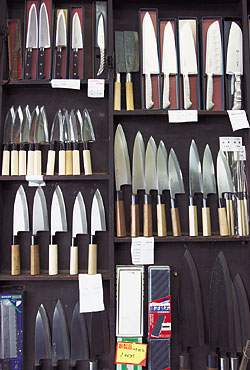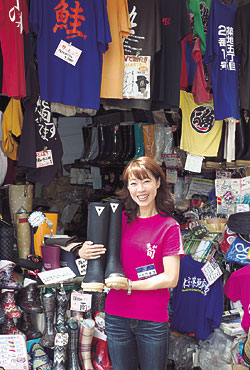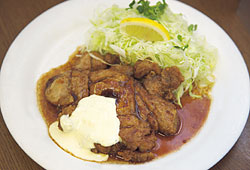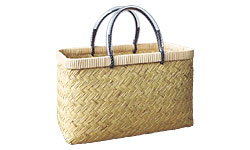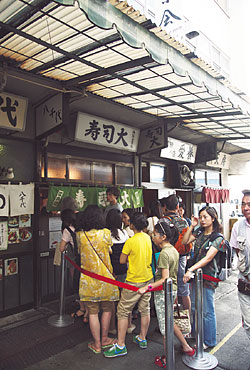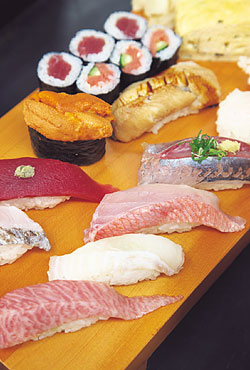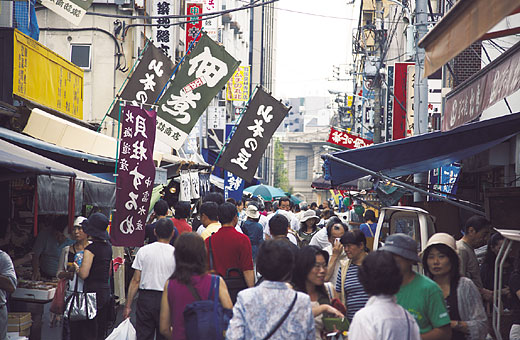Japan Travelogue Tsukiji Market
We go outside, leaving the building containing the auction hall and the brokers’ outlets. Right in front of us is Uogashi Yokocho, home to many sushi shops serving fresh seafood just brought in from the market next door. We decide to eat at Sushidai. It is still not 7 a.m. but a line of people has already formed outside. Once inside, we see chefs making sushi right in front of us—generous portions of tuna and simmered anago eel (common Japanese conger), golden eye perch and other types of scrumptious looking seafood on sushi rice. Customers waste no time popping the sushi in their mouths, and we follow suit. Each mouthful yields the fatty sweetness of fresh fish that soon has us asking for more.
Actually, Uogashi Yokocho has a lot more than just sushi shops and places serving Western food and drinks. Some stores sell knives, cooking utensils, packing materials and other items mainly for business enterprises. One outlet, Ito Uroko, was the first manufacturer in Tsukiji to make boots from natural rubber. They still make and sell boots, and the soles are slip-resistant even on surfaces covered in fish fat. The boots are also popular among sports fishermen and other outdoors enthusiasts.
Another store, Miyakoya, displays a wide selection of knives, including cleavers to cut and clean fish, and knives to slice up sashimi. Inside the store we see an American couple. The husband has a cleaver in his hand, eyeing it like a professional seafood merchant. The Tsukiji market is now on some lists of must-see places for tourists from abroad.
After strolling around Uogashi Yoko-cho a while, we see it is after 9 a.m. The seafood from the auction has all been brought in and displayed, and things are less hectic now. Since we are in the world’s largest fish market, we might as well buy some fish to take home! The problem, though, is that the market has almost no retail outlets—the brokers sell only to retailers, chefs, and other professionals and business people. So we go to a nearby mall called Jogai Shijo (“Outer Market”), located on the north side of the market grounds.
Here, too, the shops are packed in tight. There is lots of fresh seafood, and dried foods like bonito flakes and kombu seaweed. Other specialty shops handle prepared food like Japanese-style omelets, and goods like pottery and porcelain. There are also places to eat and drink. Some serve bowls of rice topped with sashimi, others specialize in ramen noodles. We are still full, so we just have fun walking around and watching. Men in front of fish shops with hachimaki bandanas around their heads call out in deep baritones, “Rasshai, yasui-yo, yasui-yo!” (“Come in, it’s cheap here, really cheap!”). Every business seems busy, and in the passageways potential customers crowd about with us. We remember why we are still here—to buy some kind of fish. And to enjoy lots more at Tsukiji. After all, the day is still young. ![]()
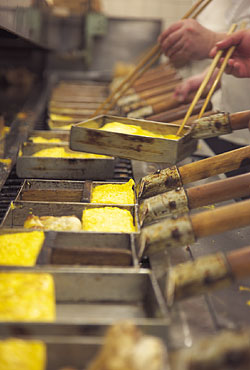
Omelet made at a shop called Shoro, in Jogai Shijo. On Saturdays, you can try your hand at making this type of omelet here.
